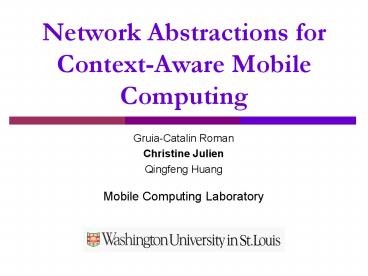Network Abstractions for ContextAware Mobile Computing PowerPoint PPT Presentation
1 / 17
Title: Network Abstractions for ContextAware Mobile Computing
1
Network Abstractions for Context-Aware Mobile
Computing
- Gruia-Catalin Roman
- Christine Julien
- Qingfeng Huang
- Mobile Computing Laboratory
2
Context-Aware Computing
- In the highly dynamic ad hoc environment, both
hardware and software components are constantly
moving and changing - In context-aware computing, application
components adapt to their environment - We extend the scope of a components context to
include information anywhere in the network - Our new notion of context is also location and
motion sensitive
3
Objectives
- Simplify mobile application development
- Provide generalized view of context extended to
include information about distant hosts - Provide more flexibility to applications by
allowing application specific context
specifications - Provide transparent maintenance of these contexts
- Help programmer cope with problems inherent in ad
hoc networks
4
Motivating Example
Charlie
Angie
5
Solution Strategy
- Allow computational components to have multiple
contexts that change over time - Expand contexts to encompass a neighborhood
surrounding the specifying component - Provide a mechanism for declarative
specifications of these contexts - Provide a protocol for calculating contexts
6
Acquaintance List Problem
- Acquaintance List set of nodes that contribute
information used to build a context for a
reference node - Network Abstraction key concept that allows
specification of this list - Treat the network as a graph and impose
application specific metric to assign weights - Compute acquaintance list using an application
supplied function that determines costs of paths
in this graph
7
Solution Sketch
- Represent the ad hoc network as a graph
- Abstract properties of nodes and links to a
weight on an edge in this graph - Calculate the cost of paths from the reference
node - Determine the shortest possible path to each
node, and build a tree of these paths - Limit this tree using a bound, D
8
Limiting the Scope
- Define a subtree of the network by placing a
bound on the cost of each path from the reference - The bound is useful only if the value of the
shortest path is strictly increasing
3
1
2
D2
2
1
1
0
1
2
1
1
2
1
Note All links have a weight of 1
9
Minimum Cost Path
3
- Given multiple paths to a node, choose the
shortest one
1
2
2
1
1
0
1
2
1
1
2
1
Note All links have a weight of 1
10
Computing Path Cost
- Assuming each link has a single weight, an
application can define a cost function - v0(Pk) Cost(v0(Pk-1), mk-1,k)
- v0(?v0?) 0
- Cost function must be strictly increasing along a
path
11
Weight Assignment
- Individualized for a particular application
- Host properties combine to form ?i link
properties combine to form ?ij - ?i can include battery power, CPU power,
physical location, and other host properties - ?ij can include physical distance, bandwidth,
throughput, and other link properties - Each links weight combines the properties of the
link in the physical network and the properties
of both nodes connected by the link - mij ?(?i, ?j, ?ij)
12
Context Calculation
- Service new queries
- Respond at the application level
- Remember the cost, the parent, the sequence
number, and information about the computation - Propagate the query
- Service shorter distances (same sequence number)
- Remember the cost and the new parent
- Propagate the query
- Disregard longer distances (same sequence number)
- But remember the cost if within bound
- Halt when computation reaches boundary
- Similar to ad hoc routing protocols
13
Protocol Example
Query (source, new cost, ) State cost,
parent, ... (neighbor, cost through neighbor),
Bound 6 Cost additive
0, null,
r
(r, 4, )
(r, 2, )
4
2
(b, 5, )
2, r,
3, a,
4, r,
1
a
b
(r,2), (b,5)
(r,2)
(r,4)
(r,4),(a,3)
(a, 3, )
5
1
(b, 4, )
(b, 5, )
4
c
d
5, b,
4, b,
(b,4)
(b,5)
14
Context Maintenance
- Persistent queries require context maintenance
- During context calculation, remember costs to
other neighbors - React to increase in link weights
- If parent, adjust cost and propagate information
- Otherwise update local information
- React to decreases in link weights
- If non-parent link, recalculate the cost for the
neighbor on the other end - Regain resources when context is no longer used
15
Maintenance Example
Query (source, source cost, new cost,
) State cost, parent, (neighbor, cost
through neighbor),
Bound 6 Cost additive
0, null,
r
4
2
4, r,
2, r,
3, a,
6
1
a
b
(r,2), (b,10)
(r,2), (b,5)
(r,4),(a,3)
(r,4),(a,8)
(r,4)
(r,2)
5
1
(b, 5, )
4
d
c
5, b,
4, b,
(b,5)
(b,4)
16
Conclusions and Future Work
- Declarative specifications provide flexible and
general treatment of context - Protocol shows feasibility of transparent context
maintenance - Weaken strong atomicity assumptions
- E.g., we assume each configuration change to be
atomic - Optimization opportunities that consider
interactions between multiple contexts
17
Thank you
- For more information
- http//www.cs.wustl.edu/mobilab

